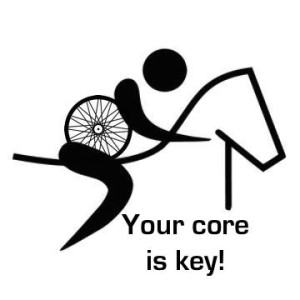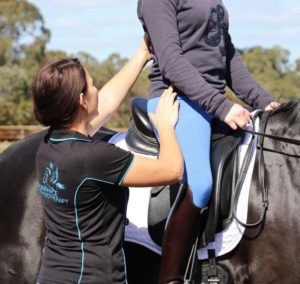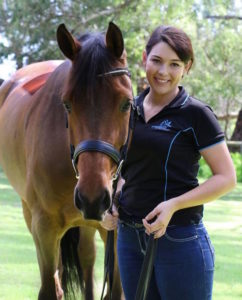Beth Watson is a physiotherapist living in Perth, Australia. Here, she lends yet another excellent point of view to our focus on Rider Fitness, especially core fitness.
Clinician Wendy Murdoch suggested in a recent article that “core strength is counterproductive to good riding.” We disagree.
Watson, owner of Performance Physiotherapy, works with horses and riders. We welcome her as a contributor. Read more  Rider Fitness articles here.
Rider Fitness articles here.
Watson writes:
The core, particularly in a rider, is not isolated but one part of your entire body moving in concert: think of the spine as a tower encased in a cushioned barrel. There are back extensors, abdominals, diaphragm, pelvic floor, and glutes forming an airbag cushioning system around the spine.
You want to be able to be able to move your spine in all directions and be able to activate this support network efficiently. Ms. Murdoch mentions the healthy core and posture of a baby – that’s because babies use their cores in a variety of postures throughout the day. I would love to see adults do this, but most adults spend at least six hours at a desk per day. Adult musculoskeletal life is not at all like a baby.
To add to this, if you have a back injury, your body goes all out of whack; fast and slow twitch muscle fibers decondition at different rates. Instead of providing a beautiful cushioning system, this deconditioning contributes to poor posture and alignment and can cause more pain. If you spend lots of time at a desk, this issue will only be exacerbated.
This is why specific core retraining programs can be useful. Please note that this training is distinct from balance work. Balance
is equally as important but needs to be addressed specifically.
You do not have to do heaps of repetitions of non-functional exercises in order to improve core strength. Functional training should be the star of your show. It’s all about awareness of your body and what muscles are activating and being able to take that movement memory into lots of situations. Having core strength for us mere mortals isn’t about doing the plank for hours. It’s about moving your spine in a healthy way.
Training equestrian riders to have a strong core is much more complex than prescribing exercise. Mental awareness and visualization of this system and how it works can be as important as the physical strength itself. If the ability to fine tune and accurately activate the muscles in the riders back is not there, it is impossible to tweak your position to go with the horse, and indeed help the horse through its work.
If you are a rider who:
- already has a strong core
- spends little time at a desk
- has no previous injuries
then there may indeed be little benefit to core training. Otherwise, there are  excellent benefits in undertaking specific training to optimize activation of your core.
excellent benefits in undertaking specific training to optimize activation of your core.
Having good core strength correlates with a healthy spine and good posture. It’s essential for riders to carry out their sport.
For the average rider who may be time-poor, it may be more appropriate to focus on training movement in a way that activates the muscles appropriately as opposed to focusing only on ‘core strength’ training. An example that comes to mind is the plank exercise which may encourage incorrect activation of the core muscles in some cases.
A combination of mental visualization, understanding the core unit, functional training through daily activities, and specific strengthening provides the greatest benefit in the least amount of time. Riders can find ways to train smarter, not harder. Remember core strength is still essential for those who wish to ride and train their horses with success.

As a Medical Imaging Technologist, coach and having trained and competed to Grand Prix. Plus competing at Grand Prix 8 weeks after having a zipper installed to have my son. I too disagree with Wendy Murdoch. Core is integral from the pelvic floor to the diaphragm and abdominal obliques. IMO children ride well as they have no fear have and not developed bad habits. Just like a child will lift a box with bent knees. Adults have to be training in manual handling to bend their knees when lifting.